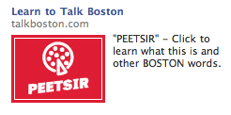A few months back, The Ad Contrarian — a hardcore skeptic around Facebook ads, if ever there was one — wrote the following about Native Advertising [emphasis mine]:
Nobody seems quite sure what they mean by native advertising. But I think I know what they mean. They don’t know it yet, but they mean using traditional advertising strategy on the web.
They mean that if you insert advertising into an appealing environment and you make the advertising entertaining or beautiful or interesting, you’re more likely to attract some attention from consumers. Which is the exact premise on which traditional advertising is built.
What is TV advertising about? It is about finding the most appealing programming and inserting into that programming messages that are either entertaining or interesting or beautiful.
This post was in response to an Mashable article on Native Advertising which, at one point, defined native ads as: “unique and native to the experience” of the site.
And this brings up the question: wouldn’t “native to the site” vary by Website and platform?
An advertisement that would be native to The New Yorker likely wouldn’t be native to Vogue, whereas a Vogue fashion ad (as Mashable’s article points out) could be seen as the ultimate in Native Advertising, with the ads often being the most appealing part of the magazine.
So, obviously, any truly native ad has to match the look, feel, purpose, and primary interest of the platform you’re advertising on. And for Facebook, this is where things REALLY get interesting.
Because in a certain sense any page post or promoted story ad on Facebook could be seen as “native” in that they are displayed as a natural or native part of a Facebook user’s news feed.
But in another sense if the ad is badly targeted or inherently uninteresting, it’ll still stick out like a sore thumb — or a disagreeably intrusive ad — while you’re scrolling through your newsfeed.
So if a native format doesn’t guarantee a native ad, then what does?
Two things:
1) Appropriately targeted ads. If it’s relevant and interesting, it’ll work better as an ad AND blend into the newsfeed better.
2) Inherently social content — something the recipient will want to share, either because it’s humorous, curiously counterintuitive, or because it says something that the reader strongly believes in.
If you combine these factors with a native-friendly ad format, you’re golden. But in my opinion, if you have to sacrifice one or the other, targeting/social content vs. format, I’d recommend sacrificing the format over the targeting and social content. Because if the social content is good enough, users will share your ad as a post, and you’ll get the format for free.
Here’s a great example:
The “Talk Boston” website is part of an ingenious content marketing and native advertising campaign for Dish Satellite TV.
The site is Onion-esque in its “Boston as a Second Language” premise, and quite a bit of the content is just pure humor, with only slivers of advertising set-up to promote Dish’s Hopper (“Hoppah” in Boston) feature.
So here’s the point — the Facebook ads promoting Talk Boston are regular old Facebook ads that show up on the far right-hand column — not page posts or promoted stories.
Yet if you’re from New England (I grew up in Maine), you’ll invariably find Talk Boston worth sharing with your buddies, as I did. So even though the Talk Boston ad wasn’t in a native format, its CONTENT was inherently social, and the ad itself was well targeted. So the format became a non-issue — to the point where Dish got into my friend’s news feeds for free, when I shared the link to TalkBoston.com with them.
Obviously, an advertiser will want both native format and native content for maximum performance, but it’s pretty clear to me which part of that equation is the most important. Moreover, I believe that the concept of Native advertising represents the future of Facebook advertising, and quite possibly of all advertising.
To quote the advertising legend Howard Gossage, “Nobody reads ads. People read what interests them. Sometimes it’s an ad.” Native advertising follows this formula by demanding that ads be interesting in their own right — interesting enough to add to the user experience of the platform (website, magazine, etc.) rather than detract from it.
And isn’t that what everyone wants? Facebook wants to advertise to users without feeling intrusive or angering their audience. Users want to continue enjoying Facebook as a free service without their news feeds being interrupted by annoying ads. And companies want Facebook ads that actually get read and responded to.
How could Native advertising NOT be the future? At least that’s how I see things.
What do you think? What has your experience been with native advertising? Let me know in the comments.



